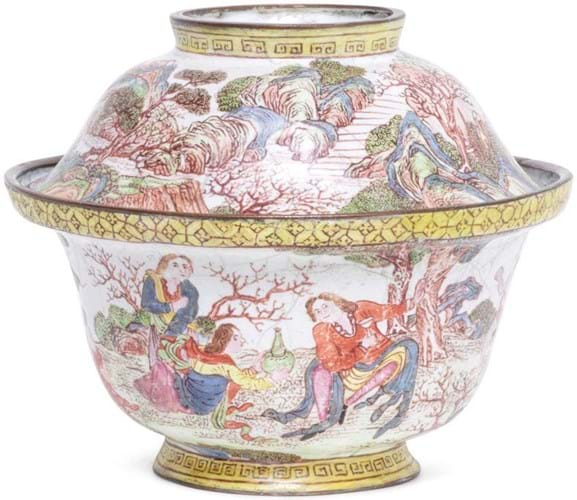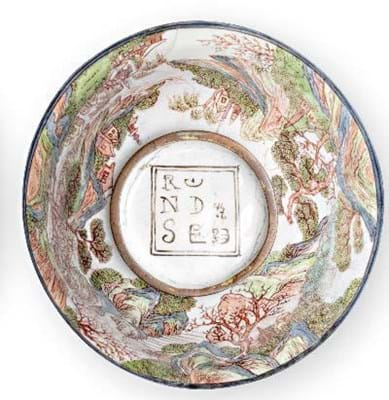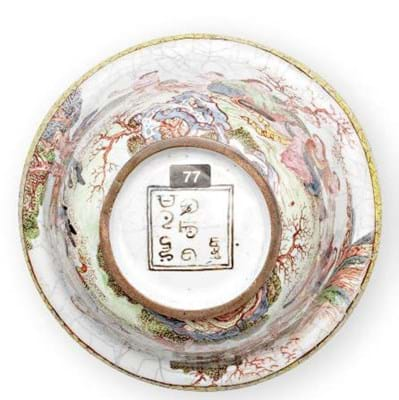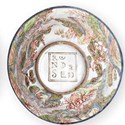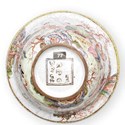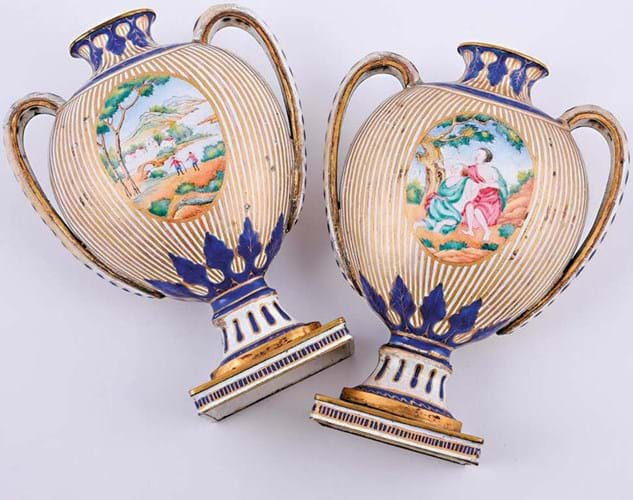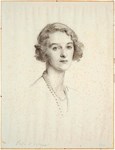European missionaries, present in China since the 16th century, contributed significantly to Qing art.
The emperor Kangxi (1662-1722) and his successors Yongzheng (1722-35) and Qianlong (1736-95) all welcomed the artistic and technical advances Jesuits brought to the court – particularly the technique of painting enamels onto metal.
A rare 18th century painted enamel ‘Jesuit’ bowl was among the best performing lots in the Asian Art sale at Bonhams Knightsbridge (27.5/25% buyer’s premium) on May 9-10.
Measuring 5in (12cm) across and decorated with European subject matter – a continuous landscape scene of ladies and gentlemen at leisure attended by young boys dressed as putti – both the base and the cover are inscribed in black enamel with an eight-character Jesuit mark.
As it uses early enamel colours, it probably dates to the Yongzheng period and would probably have been made for one of the Jesuit missionaries at the court.
Sold without reserve and given an estimate of £800-1200, it took £18,000.
Duesbury copy
The rare pair of Chinese export enamel vases offered at Dreweatts (25% buyer’s premium) in Donnington Priory on May 18 were probably made in Canton towards the end of the reign of Qianlong or early in the reign of Jiaqing.
They are painted with oval panels to each side with figures standing in a European landscape against a stripe blue and gilt ground. If the neoclassical form looks familiar that is because it copies a model produced at the Chelsea-Derby factory by William Duesbury in the late 1770s.
Chinese copies were presumably made to order for British or American customers c.1780-85. A single vase of this rare type is in the Victoria and Albert Museum.
This pair (with some old restoration and chips to the enamel) came for sale by descent from the estate of Henry Lane Eno (1871- 1928). A member of the Eno real estate banking family, he moved from New York to Montacute House in Somerset after marrying his much younger English bride Flora Napier.
Estimated at £400-600, the vases sold at £14,000.
Another rare export lot in the Newbury sale was a 42-piece Chinese part service. Until it sold online at £4500 it had been in the same family since purchase in c.1755.
The service, made for the Rev William Taswell (1708-77) and enamelled with the Taswell arms, is mentioned in his will written in 1775. He wrote: “I leave to my son George Taswell (now residing as I suppose at Madras in India) my two half pint silver cups and all such China in my possession as shall be found marked with my family’s arms.”
In 1814 George left “the whole of the China ware on which are the arms of the family” to his younger son George Morris Taswell, also employed by the East India Company.
William was the rector of Wotton-under-Edge in Gloucestershire but a member of a family who had been merchants in the City of London from Elizabethan times. His father Dr William Taswell (1652- 1731) had been page to the Dean of Westminster in 1666 when he witnessed the Great Fire of London; he later wrote a vivid account of the event.
It is rare to have specific contemporary records relating to Chinese armorial porcelain. Of an estimated 5000 bespoke services sent back to Britain from China during the 18th century, there are perhaps only a dozen instances that can be linked to contemporary records.On the market for the first time in its history, it sold just below estimate.


